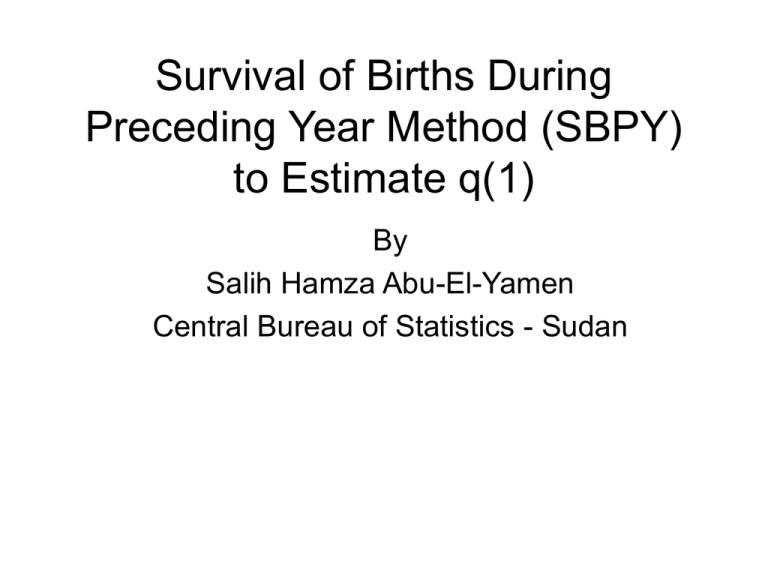
Survival of Births During
Preceding Year Method (SBPY)
to Estimate q(1)
By
Salih Hamza Abu-El-Yamen
Central Bureau of Statistics - Sudan
Introduction:
* q(1) is defined as the probability of dying from birth before
reaching the first birth date
* It is an important demographic indicator which reflects the
health and socioeconomic conditions of the population
* It is directly and easily calculated from Birth and Deaths
Registration Systems provided that these system are
complete and accurate
* Where these systems are not complete or accurate
demographers developed different indirect techniques to
estimate child mortality indicators from different types of
data collected through censuses or surveys
* One of the famous and often used indirect technique is
Brass method to estimate child mortality from data on child
survival
* Recently a direct method has been developed using data
on child birth history. The DHS survey was the pioneer in
this regard
* Since then the subject started to be controversial as
which method is the best estimator of these indicators
* In this paper we introduce a new method to estimate q(1)
from data on survival of births during the year preceding
the census or survey which support the pro-Brass scholars
Objectives
1. Development of new method to estimate q(1)
2. Assessment of the differences of q(1) calculated by
SBPY and Brass methods
3. Assessment of the impact of data errors on the
differences of estimates from the two methods
4. Initiation of a measure to assess the impact of
errors in data used by different methods to estimate
indicators, on the value of estimates
5. Provision of q(1) estimates by different methods for
the studied countries and their subdivisions
1. SBDPY method to estimate
q(1)
Data:
1-Births during the year preceding the
census or survey
2-Number of them died
Questions (two alternatives):
A-Whether there is a live birth during the
year preceding the census or survey and
whether he/she is alive
B-Date of birth and death of last live birth
Assumptions:
Births and deaths are evenly distributed through
the 12 months preceding and following the census
or survey
Rationality:
* The number of deaths from births in the first
month of the 12 months preceding the census or
survey is estimated by a factor based on the above
assumption. Hence q(1) is the probability of death
of births born alive in the first month before
completing the 12th month
Dec
Nov
Oct
Sep
Aug
Jul
Jun
Expected
Units of
Deaths
May
Apr
Mar
Feb
Jan
Dec
Nov
Oct
Sep
Units
Of Deaths
Aug
Jul
Jun
May
Apr
Mar
Feb
Jan
Births
J
F
M
A
M
J
Jl
A
S
O
N
D
Method:
B = Number of births during the preceding year
n = The average number of births = B/12
D = Number of deaths during the preceding year
f = 12/(1+2+3+4+5+6+7+8+9+10+11+12)
= 12/78
= 0.5138
d= D*0.5138
q(1) = d/n
Advantages:
1- Simple method that uses simple calculations
2- Data used likely to be of good quality
3- A direct method that uses direct information
Disadvantages:
1- As for many methods of calculation of
demographic indicators it is based on assumptions
that may not always be true
2 - Assessment of the differences
of q(1) calculated by SBPY and
Brass methods for 140 records
Unit of research:
* The research units are: a country, a country subdivision,
resource of data in a country and population subgroup
* The countries are Brazil, Ethiopia, Egypt, India, Sudan
and Turkey
* The resources of data are the 1983 and 1993 population
censuses in Sudan
* The population subgroups are urban/rural & male/female
* The above units account for 140 records
Sources of data:
1- DHS Surveys Archive
2- Sudan 1983 population census
3- Sudan 1993 population census
Data processing:
1- For DHS data the required information for the
six countries and their subdivisions obtained by
processing the row data from DHS Archive using
SPSS
2- For the 1983 population census in Sudan the
required information are obtained from the
Tabulation reports
3- For the 1993 population census in Sudan the
q(1) estimates by the two methods already
calculated by the author in the 1993 Census
Analytical Report
Methodology:
1- Calculation of q(1) by SBPY method and Brass
Adjusted method for the 140 records
2- Testing the significance of the differences
between the two sets of estimates
The variables:
1- Three variables of q(1) by the two methods and
the difference between them
2- Four variables of four groups of differences:
lower than 6 per 1000
lower than 11 per 1000
lower than 16 per 1000
lower than 21 per 1000
3- Four variables of percent difference of the
above four groups
Methods:
* Classification of records into a number of subgroups
1- Census records
2- Survey records
3- Total unit records
4- Individual countries and subdivision records
* Calculation of differences of q(1) for the subgroups of records
* Examining the percent number of records by the four groups
of differences for the above subgroups of records
* Using paired t-test to examine the value and the significance
of the mean difference
* Using one t-test to examine whether the mean difference
differs from a specific value
Results
All sources; censuses, surveys & total subgroups
Source
Difference in q(1) per 1000
<6
< 11
< 16
Total
Number
Records
< 21
All sources
26%
44%
51%
67%
140
Censuses
30%
48%
56%
74%
80
Surveys
22%
40%
45%
58%
60
Total units
46%
77%
92%
100%
13
Countries
Source
Difference in q(1) per 1000
<6
< 11
< 16
Total
Number of
Records
< 21
Egypt
14%
14%
29%
57%
7
Brazil
50%
100%
100%
100%
4
Turkey
50%
67%
67%
67%
6
India
22%
41%
44%
67%
27
Ethiopia
11%
11%
22%
22%
9
0%
43%
43%
43%
7
Sudan 1983
19%
28%
39%
64%
36
Sudan 1993
35%
65%
65%
65%
17
Sudan 1993
adv.
41%
63%
74%
93%
27
Sudan
Small differences
Source
Difference in q(1) per 1000
0
All
sources
1
6
2
4
Total
Number
of
Records
3
5
8
140
Paired t-test
Variable
Mean
q(1)_BDPY
99.7
q(1)_Brass
94.3
Paired Difference
Mean
t
Sig.
5.4
2.04
0.043
One t-test
Fixed Value
t
Sig.
1
1.661
0.099
2
1.281
0.202
3
0.902
0.369
4
0.523
0.602
5
0.144
0.886
6
-0.236
0.814
7
-0.615
0.540
8
-0.994
0.322
9
-1.374
0.172
10
-1.753
0.082
11
-2.132
0.035
Figure I: q(1) Estiamtes of Research Units by SBPY and Brass
Methods
300
q(1) per 1000
250
200
150
100
50
137
133
129
125
121
117
113
109
105
101
97
93
89
Research Units
85
81
77
73
69
65
61
57
53
49
45
41
37
33
29
25
21
17
13
9
5
1
0
Figure II: q(1) Percent Number of Research Units by Data
Source and Level of Difference in q(1) Between SBPY
Method and Brass Adjusted Method
120%
100%
All sources
Censuses
Surveys
80%
totals of all
60%
40%
20%
0%
<6
<11
<16
Level of difference in q(1)
< 21
Level of difference in q ( 1)
Figure III: q(1) Percent Number of Research Units by
Country and Level of Difference in q(1) Between
SBPY Method and Brass Adjusted Method
Brazil
<21
Turkey
India
<16
Egypt
Sudan
<11
Ethiopia
<6
0%
20%
40%
60%
80%
100%
120%
Figure IV: Percent Number of Sudan-Census Reseach
Units by Source of Data and Level of Difference in q(1)
Between SBPY Method and Brass Method
100%
80%
60%
Sudan 83
Sudan 93
Sudan adv
40%
20%
0%
<6
<11
<16
Level of Difference in q(1)
<21
Figure V: q(1) Estimates of DHS Research Units by DHS Method, Brass
Adjusted Method and SBPY Method
250
DHS
q( 1) per 1000
200
150
SBYP
Brass
100
50
0
1 3 5 7 9 11 13 15 17 19 21 23 25 27 29 31 33 35 37 39 41 43 45 47 49 51 53 55 57 59
Figure VI: q(1) Estimates of Sudan-Census Research Units by SBPY Method and Brass Adjusted Method
300
SBYP
q(1 ) per 1000
250
Brass
200
150
100
50
0
1 3 5 7 9 11 13 15 17 19 21 23 25 27 29 31 33 35 37 39 41 43 45 47 49 51 53 55 57 59 61 63 65 67 69 71 73 75 77 79
3 – Impact of data errors on the
differences
The variables:
* Two groups of variables
A – First group - differences variables:
1-differences lower than 21 and higher
than 20 per 1000
2- differences by multiple options
B – Second group – data quality variables:
1- sex ratios of children ever born
2- no. of births during preceding year
3- standard deviation of births
Methodology:
* Chi square test for the relationship between the
difference variable and the sex ratio, the number of
births and the standard deviation variables
* Linear regression between difference variable as
a dependent variable and the sex ratio, the
number of births as independent variables
* The correlation coefficients between the
difference variables and the data quality variables
Chi Square Test: Difference and Sex ratio
Difference in q(1) per 1000
Sex ratio of children ever born
102-107
Total
<102 or >107
=<10
34
22
56
11-20
12
9
21
>20
12
24
36
Total
58
55
113
Pearson Chi Square = 6.925 (a)
Sig. = 0.031
a. 0 cells (.0%) have expected count less than 5.
Chi Square Test: Difference and No. of Births
Difference in q(1) per 1000
Births
=<400
401-800
Total
801-10000
>10000
=<10
13
5
8
34
60
11-20
3
3
5
19
30
>20
22
4
6
16
48
Total
38
12
19
69
138
Pearson Chi Square = 14.526 (a)
Sig. = .024
a. 3 cells (25.0%) have expected count less than 5.
Chi Square Test: Difference and Std Deviation
Difference in q(1) per 1000
Standard deviation
0-5
5-10
Total
> 10
=< 20
11
13
11
35
> 20
14
9
2
25
Total
25
22
13
60
Pearson Chi Square = 5.81 (a)
Sig. = 0.055
0 cells (.0%) have expected count less than 5.
Linear Regression: Difference with Sex Ratio
Model
Coefficients
B
t
Sig.
Standard Error
Constant
1.754
0.478
3.667
0.000
Sex Ratio
0.832
0.305
2.728
0.007
Adjusted R^2 = 0.054
Linear Regression: Difference with No. of Births
Model
Coefficients
B
Constant
Births
t
Sig.
Standard Error
3.924
0.337
11.639
0.000
-0.270
0.107
-2.511
0.013
Adjusted R^2 = 0.037
Linear Regression: Difference with Sex Ratio & Births
Model
Coefficients
B
t
Sig.
Standard Error
Constant
2.721
0.590
4.612
0.000
Sex Ratio
0.770
0.301
2.562
0.012
-0.314
0.111
-2.842
0.005
Births
Adjusted R^2 = 0.122
Correlation Coefficients
Difference in q(1)
Sex Ratio of CEB
N=113
Births
N=138
Standard
Deviation
N=60
Standar
d
Deviatio
n
N=38
Difference =<5 _ > 5
Difference =<10 _ > 10
Difference =<15 _ > 15
Difference =<20 _ > 20
0.062
-0.140
-0.032
*0.347
0.045
-0.153
-0.168
0.116
0.059
*-0.188
-0.235
-0.008
0.172
**-0.285
*-0.307
-0.028
**0.251
*-0.211
-0.183
0.120
*0.235
**-0.233
-0.244
0.076
Difference_code_1 (a)
Difference_code_2 (a)
4 – Initiation of a measure to
assess the impact of data errors on
the values estimated by different
techniques
Introduction:
* Different demographic techniques of estimates
come with different values for the same population
* Errors in data used by different techniques
contribute to these differences
* To evaluate the relationship between errors in
data and the technique estimate, the Specific
Sensitivity of Technique (SST) is defined as the
deflection of the estimated value as a result of a
unit increase in the enumerator data used by the
technique
Method:
* Data: any hypothetical data as specified by the
technique for a number of cases
* Steps:
1- Calculation of the indicator values by the
specific technique for all the cases
2- Increasing the value of the enumerator by
a unit for the different steps of calculation
3- Recalculate the values of the indicator for
all the cases
4- Subtract the estimates in step 1 from that
in step 3
5- Calculate the average differences in step
4 to be the SST measure
Applications:
A- The SST for SBPY method to estimate q(1)
found to be = 1.85
B- The SST for Brass adjusted method to estimate
q(1) found to be = 0.96
C- q(1) estimated by Brass adjusted method is
less sensitive to data errors than the SBPY
method by around 50%
Summary of findings and implications:
1- Generally speaking the differences between the two
methods are somewhat small and they are not far from the
limit of differences usually encountered between different
methods
2 - The quality of data used by Brass adjusted method and
the size of births used by SBPY method play important role
in the difference of estimates by the two methods
3- For small sizes of births the validity of evenness
assumption of SBPY method has a significant contribution
to the differences in q(1) estimates
3- The SBPY method competes as a powerful estimate of
q(1) for large sizes of births, and good quality of data which
usually emerge from censuses and high quality surveys
4- The Brass adjusted method is supported as a powerful
technique for estimation of q(1) in the case of good quality
of data on children ever born and number of them surviving
5- For population surveys estimates of q(1) from Brass
adjusted method are lower than those from SBPY method
and higher than those from Births history data method
6- The above findings imply that q(1) values estimated by
Births history data method are likely to be underestimated
Thanks








